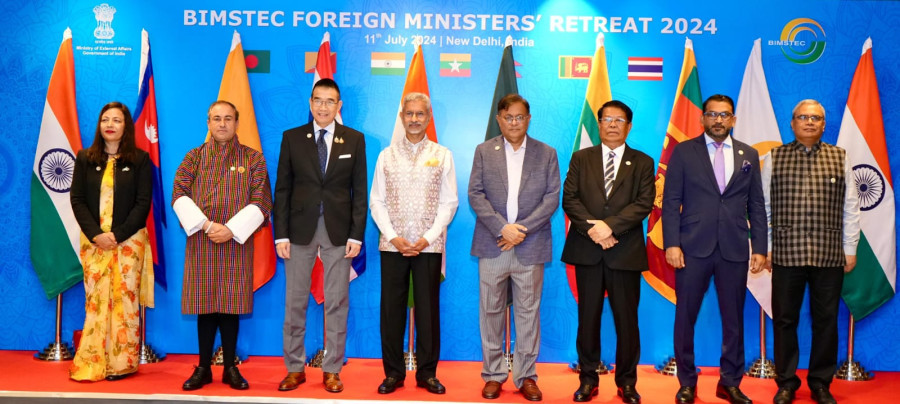Columns
Whither BIMSTEC?
For Nepal and Bhutan, BIMSTEC acts as a forum to improve their foreign policy interests.
Smruti S Pattanaik
The second Bay of Bengal Initiative for Multi-Sectoral Technical and Economic Cooperation (BIMSTEC) Foreign Ministers’ retreat was held in Delhi on July 11-12. This was when the BIMSTEC initiative slowed down, with each country having other priorities. Many saw BIMSTEC as an alternative to SAARC, as the regional organisation was revived as a cooperation vehicle in the Eastern part of South Asia. It now has a Secretary General with a Secretariat based in Dhaka and adopted a charter only recently, even though the organisation came into existence in 1997. Yet efforts are being made for regular meetings and dialogues among the officials of states to take the initiative forward and make progress on the 14 priority areas.
Pushing the agenda forward
Since 2023, the BIMSTEC Foreign Ministers’ retreat has become a regular event. Founded in 1997, the organisation held its fifth summit in Colombo in March 2022, where the charter was adopted after more than 20 years. This reflects the lack of commitment of member countries to take the process forward.
While India sees BIMSTEC as a vehicle for its Act East policy to engage with South East Asia and as a gateway for the South Asian region, Myanmar and Thailand’s expectations are limited as they are already a part of ASEAN. Bangladesh, which has projected itself as the hub of connectivity and has a Look East policy, is also the lead country for connectivity projects and has been an active member of the group. For Nepal and Bhutan, BIMSTEC acts as a forum to improve their foreign policy interests and provide these countries with access to the sea through multiple countries within a regional framework.
The BIMSTEC region brings together 167 billion people, incorporating 22 percent of the world population and a combined GDP of $3.71 trillion.
India and BIMSTEC
While the organisation moves slowly, ironing out differences between member states to establish seamless trade and connectivity, India has prioritised BIMSTEC in its foreign policy—from BIMSTEC outreach in the BRICS meeting that India hosted at Goa to inviting the BIMSTEC leaders to attend the swearing-in of Prime Minister Modi’s government in 2019. India hosted the first meeting of the BIMSTEC Energy Centre governing board in Bengaluru in 2023 to suggest a road map for meaningful intra-BIMSTEC cooperation, among other issues.
India is the lead country in BIMSTEC, collaborating in transport and communication. For India, BIMSTEC promises to connect its North-East terrain to the growing regional markets in South-East Asia. It promises connectivity and access to the port in the North-East region. While regional connectivity within the BIMSTEC framework is taking time to fructify, India is already working within the sub-regional and bilateral frameworks. For example, its effort to establish connectivity with Bangladesh would go a long way as a building block for BIMSTEC connectivity. It is similarly engaged with both Nepal and Bhutan to build road, rail, waterways and grid connectivity.
It is speaking of the land bridge with Sri Lanka and underwater cables, as well as the restart of ferry services with Myanmar. It is engaged in the Kaladan multimodal project and has access to Sittwe Port, inaugurated in May 2023 and has been operationalised. The trilateral highway promises to link India to Thailand through Myanmar. After the Arakan Army captured the Paletwa township near the Mizoram border, the road project of nearly 110 km connecting Peletwa to Zorinpui at Mizoram will be in cold store for some time. The Arakan Army has said they would want the project to continue and harness mutual benefit; India is closely watching the situation. It has completed 70 percent of the trilateral highway, but the security situation in the Sagaing Region of Myanmar has not allowed the completion of the project. Once built, this project will help the BIMSTEC member states.
Transport, connectivity and trade
Enabling the environment to conduct trade remains a priority. The Framework Agreement on the BIMSTEC Free Trade Area (FTA) was signed on February 8, 2004, but has yet to conclude an FTA. There have been discussions to remove tariff and non-tariff barriers, rule of origin, standardise trade and progressively move towards including the service sector. A BIMSTEC Trade Negotiating Committee (TNC) has been formed. The BIMSTEC Trade Facilitation Strategic Framework 2030 points out, “India and Thailand have the most advanced facilitation environment in the region, followed by Bangladesh, Myanmar, and Sri Lanka”, emphasising a structured pathway to enhance regional trade.
Transport and electricity grid connectivity among the members of the Bangladesh-Bhutan-India-Nepal subregion would constitute a significant building bloc, leading to the advancement of some of the BIMSTEC agenda. In 2022, the member states adopted BIMSTEC's Master Plan for Transport Connectivity and are planning to establish a ‘Coastal Shipping ecosystem, of port facilities, of ferry services in the Bay of Bengal, as also power grid interconnectivity and a regional motor vehicles agreement’. According to BIMSTEC energy outlook 2035, between 2014 and 2019, the energy supply in the region has grown at an average rate of 10.72 percent.
BIMSTEC was once touted as an alternative to SAARC, even though the geographical spread of member countries is different. The Bay of Bengal, part of the Indian Ocean, remains a primary focus area of the BIMSTEC countries. The potential for sea-borne trade with the cheapest transportation cost remains attractive, given the instability in Myanmar. The first meeting of the working group on coastal shipping discussed the agreement in November 2017. A consensus on the agreement has yet to arrive.
Coastal shipping agreements already exist between India and Bangladesh. India is already using Sittwe port in Myanmar under a bilateral arrangement. Vishakhapatnam port is now open to Nepal for its external trade. An MoU was signed between the Port Authority of Thailand to use Ranong Port in Western Thailand and the Port Trusts of Visakhapatnam, Kolkata and Chennai in 2019 during the BIMSTEC Conclave of Ports.
Security Cooperation
External powers are showing increasing interest in the Bay of Bengal region. China is already building a port in Myanmar to access the Bay of Bengal through Myanmar. There is an increasing interest of the US in this region as a part of its Indo-Pacific strategy.
Combating international terrorism, transnational crime and drug trafficking remains a major concern in this region because of the Golden Triangle. The situation in Myanmar has also added to this concern.
The Tri-Services HADR PANEX series of exercises among the BIMSTEC countries also enhances individual countries’ capacity to deal with natural calamities and other challenges at home. National security adviser-level meetings also facilitate dialogue between the member countries on the security challenges that the region faces. These meetings also complement the Colombo Security Conclave, which discusses security issues among the Indian Ocean littorals. Intra-regional tourism can be increased through visa liberalisation, which will also contribute to people-to-people contact.
The second Foreign Ministers’ retreat in Delhi is essential to take the process forward. However, given the slow progress, BIMSTEC has yet to make its mark. There are several bilateral disputes between the member countries, but those have never posed a challenge to cooperation, as seen in the SAARC context. The pace of the summit meeting has acquired gravitas. Thailand is going to host the sixth summit in September. Given the region’s economic and trade potential, it is expected that the leaders of member countries rise to the occasion to make the cooperation in Eastern South Asia a grand success.




 6.1°C Kathmandu
6.1°C Kathmandu















